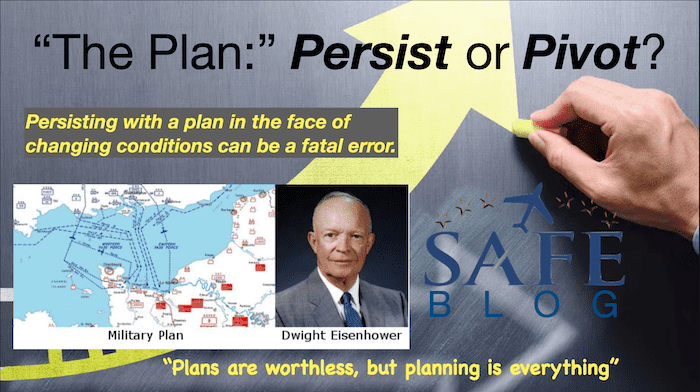
 There seems to be a cultural ethos that mandates “staying the course” or “completing the mission as planned.” However, in the aviation business with the inherent uncertainty of weather conditions and ATC demands, flexibility – and ability to change the plan – are critical to safety (and a sign of greater intelligence). Staying glued to the originally constructed plan when the environment and ATC conditions change is exactly the causal factor we see in many accidents.
There seems to be a cultural ethos that mandates “staying the course” or “completing the mission as planned.” However, in the aviation business with the inherent uncertainty of weather conditions and ATC demands, flexibility – and ability to change the plan – are critical to safety (and a sign of greater intelligence). Staying glued to the originally constructed plan when the environment and ATC conditions change is exactly the causal factor we see in many accidents.
So, when should we persist and when should we pivot?
The real answer here is dictated by the degree of change and the risks. It is essential to set alternates (with very quantifiable triggers) during your preflight planning (in fact, CFR 91.103 *requires* alternate plans) “If this…, then pivot!” In aviation, most diversions are dictated by the accuracy of the “weather guess” (all forecasts are “educated weather guesses?!”). Conditions radically different from the forecast necessitate a spring-loaded diversion along a pre-planned course of action. Don’t persist into icing or a line of storms (have you seen these in AOPA recreations?)

This same mental model should also be applied on every take-off or landing. Prebrief this action every time and do not commit too early to the expected plan. “If anything critical happens on the takeoff roll, we reduce throttle and abort!” On landing, always be spring-loaded for a go-around. My personal mantra on short final is “Wheels, flaps, cleared to land, and a go-around is always an option here!”

 The football analogy applies here: the plan created in the huddle usually goes away as soon as the ball is snapped (expect this). Once the play is in motion, the action of the defensive line entirely determines the play (see recent weather blog). Do not get “mission mentality” and hold the ball when the blitz is on; pivot to your alternate! Read this wonderful article by Adam Grant (applies nicely to life and business too) Fly safely out there (and often)!
The football analogy applies here: the plan created in the huddle usually goes away as soon as the ball is snapped (expect this). Once the play is in motion, the action of the defensive line entirely determines the play (see recent weather blog). Do not get “mission mentality” and hold the ball when the blitz is on; pivot to your alternate! Read this wonderful article by Adam Grant (applies nicely to life and business too) Fly safely out there (and often)!
 Flight test anxiety is one of the most common obstacles to success during an FAA evaluation. It occurs at every level, from initial PPL to jet type ratings! This webinar will offer solutions based on scientific techniques to quiet those test-day butterflies and ensure a better experience. A calm, confident applicant presents their best performance on flight test day!
Flight test anxiety is one of the most common obstacles to success during an FAA evaluation. It occurs at every level, from initial PPL to jet type ratings! This webinar will offer solutions based on scientific techniques to quiet those test-day butterflies and ensure a better experience. A calm, confident applicant presents their best performance on flight test day!




